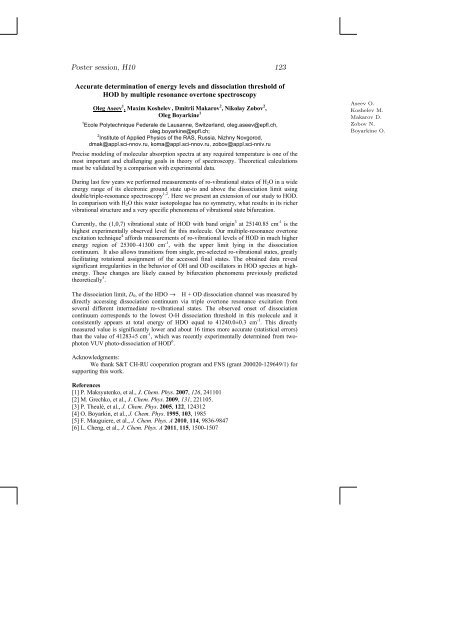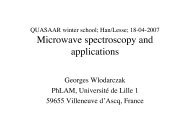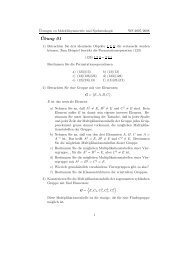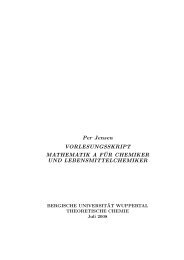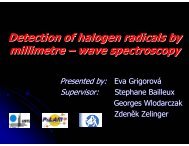Abstract book - Prof. Per Jensen, Ph.D. - Bergische Universität ...
Abstract book - Prof. Per Jensen, Ph.D. - Bergische Universität ...
Abstract book - Prof. Per Jensen, Ph.D. - Bergische Universität ...
- No tags were found...
You also want an ePaper? Increase the reach of your titles
YUMPU automatically turns print PDFs into web optimized ePapers that Google loves.
Poster session, H10 123Accurate determination of energy levels and dissociation threshold ofHOD by multiple resonance overtone spectroscopyOleg Aseev 1 , Maxim Koshelev , Dmitrii Makarov 2 , Nikolay Zobov 2 ,Oleg Boyarkine 11 Ecole Polytechnique Federale de Lausanne, Switzerland, oleg.aseev@epfl.ch,oleg.boyarkine@epfl.ch;2 Institute of Applied <strong>Ph</strong>ysics of the RAS, Russia, Nizhny Novgorod,dmak@appl.sci-nnov.ru, koma@appl.sci-nnov.ru, zobov@appl.sci-nniv.ruPrecise modeling of molecular absorption spectra at any required temperature is one of themost important and challenging goals in theory of spectroscopy. Theoretical calculationsmust be validated by a comparison with experimental data.Aseev O.Koshelev M.Makarov D.Zobov N.Boyarkine O.During last few years we performed measurements of ro-vibrational states of H 2O in a wideenergy range of its electronic ground state up-to and above the dissociation limit usingdouble/triple-resonance spectroscopy 1,2 . Here we present an extension of our study to HOD.In comparison with H 2O this water isotopologue has no symmetry, what results in its richervibrational structure and a very specific phenomena of vibrational state bifurcation.Currently, the (1,0,7) vibrational state of HOD with band origin 3 at 25140.85 cm -1 is thehighest experimentally observed level for this molecule. Our multiple-resonance overtoneexcitation technique 4 affords measurements of ro-vibrational levels of HOD in much higherenergy region of 25300–41300 cm -1 , with the upper limit lying in the dissociationcontinuum. It also allows transitions from single, pre-selected ro-vibrational states, greatlyfacilitating rotational assignment of the accessed final states. The obtained data revealsignificant irregularities in the behavior of OH and OD oscillators in HOD species at highenergy.These changes are likely caused by bifurcation phenomena previously predictedtheoretically 5 .The dissociation limit, D 0, of the HDO → H + OD dissociation channel was measured bydirectly accessing dissociation continuum via triple overtone resonance excitation fromseveral different intermediate ro-vibrational states. The observed onset of dissociationcontinuum corresponds to the lowest O-H dissociation threshold in this molecule and itconsistently appears at total energy of HDO equal to 41240.0±0.3 cm -1 . This directlymeasured value is significantly lower and about 16 times more accurate (statistical errors)than the value of 41283±5 cm -1 , which was recently experimentally determined from twophotonVUV photo-dissociation of HOD 6 .Acknowledgments:We thank S&T CH-RU cooperation program and FNS (grant 200020-129649/1) forsupporting this work.References[1] P. Maksyutenko, et al., J. Chem. <strong>Ph</strong>ys. 2007, 126, 241101[2] M. Grechko, et al., J. Chem. <strong>Ph</strong>ys. 2009, 131, 221105.[3] P. Theulé, et al., J. Chem. <strong>Ph</strong>ys. 2005, 122, 124312[4] O. Boyarkin, et al., J. Chem. <strong>Ph</strong>ys. 1995, 103, 1985[5] F. Mauguiere, et al., J. Chem. <strong>Ph</strong>ys. A 2010, 114, 9836-9847[6] L. Cheng, et al., J. Chem. <strong>Ph</strong>ys. A 2011, 115, 1500-1507


